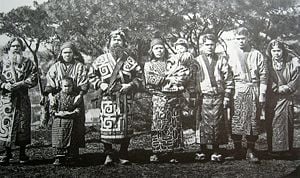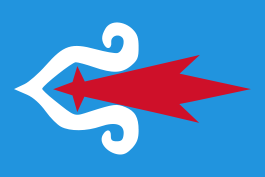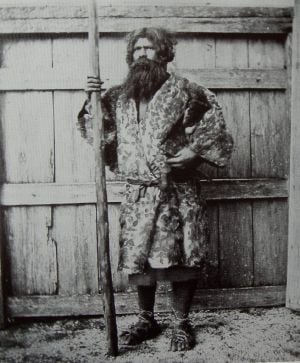Ainu
| Ainu |
|---|
 Group of Ainu people, 1904 photograph. |
| Total population |
| 50,000 people with half or more Ainu ancestry 150,000 Japanese people with some Ainu ancestry
Pre-Japanese era: ~50,000, almost all pure Ainu |
| Regions with significant populations |
| Languages |
| Ainu is the traditional language. According to research by Alexander Vovin, in 1996 only 15 fluent speakers remained, and the last speaker of the Sakhalin dialect had died in 1994. Most Ainu today are native speakers of the Japanese or Russian language. (Note that the Aini language spoken in China is unrelated). *Gordon, Raymond G., Jr. (ed.) (2005). Ethnologue: Languages of the World, Fifteenth edition. Dallas: SIL International. ISBN 1-55671-159-X. |
| Religions |
| Animism, some are members of the Russian Orthodox Church |
| Related ethnic groups |
Modern genetics has proven they are East Asians. They are usually grouped with the non-Tungusic peoples of Sakhalin, the Amur river valley, and the Kamchatka peninsula:
|
Ainu (アイヌ IPA: /ʔáınu/) are an ethnic group indigenous to Hokkaidō, northern Honshū, the Kuril Islands, much of Sakhalin, and the southernmost third of the Kamchatka peninsula. Their most widely known ethnonym is derived from the word aynu, which means "human" (particularly as opposed to kamuy, i.e., divine beings) in the Hokkaidō dialects of the Ainu language; Emishi, Ezo or Yezo (蝦夷) are Japanese terms, which are believed to derive from the ancestral form of the modern Sakhalin Ainu word enciw or enju, also meaning "human"; and Utari (ウタリ) (meaning "comrade" in Ainu) is now preferred by some members. There are most likely over 150,000 Ainu today, however the exact figure is not known as many Ainu hide their origin or, in many cases, are not even aware of it, as their parents have kept it from them so as to protect their children from racism.
Origins
Some commentators[attribution needed] believe that the Ainu derive from an ancient proto-Northern Mongoloid stock that may have occupied parts of Central and East Asia before the Han expansion (see Jomon people). Various other Mongoloid indigenous peoples, such as the Ryukyuans, are thought to be rather closely related to them. The Ainu people have a legend that says, "The Ainu lived in this place a hundred thousand years before the Children of the Sun came".[citation needed]
The prevailing mythology in Japan has been of the Ainu as a race of "noble savages," a proud but reclusive culture of hunter-gatherers. This mythology became a useful defense for the Japanese expropriation of Ainu lands. In fact, the Ainu were also farmers as well as hunter-gatherers from the earliest centuries of the Common Era.[1]
Genetic testing of the Ainu people has shown them to belong mainly to Y-haplogroup D.[2] The only places outside of Japan in which Y-haplogroup D is common are Tibet and the Andaman Islands.[3] About one in eight Ainu men have been found to belong to Haplogroup C3, which is the most common Y-chromosome haplogroup among the indigenous populations of the Russian Far East and Mongolia. Some researchers have speculated that this minority of Haplogroup C3 carriers among the Ainu may reflect a certain degree of unidirectional genetic influence from the Nivkhs, with whom the Ainu have long-standing cultural interactions.[4] According to Tanaka et al. (2004), their mtDNA lineages mainly consist of haplogroup Y (21.6%) and haplogroup M7a (15.7%).
Some have speculated that the Ainu may be descendants of a prehistoric race that also produced indigenous Australian peoples. In Steve Olson's Book, Mapping Human History, page 133, he describes the discovery of fossils dating back 10,000 years, representing the remains of the Jomonese, a group whose facial features more closely resemble those of the indigenous peoples of New Guinea and Australia. After a new wave of immigration, probably from the Korean Peninsula, some 2,300 years ago, of the Yayoi people, the pure-blooded Jomonese were pushed into northern Japan. Genetic data suggests that modern Japanese are descended from both the Yayoi and the Jomonese.
American continent connection
In the late 20th century, much speculation arose that people of the group ancestral to the Ainu may have been one of the first to settle North America. This theory is based largely on skeletal and cultural evidence among tribes living in the western part of North America and certain parts of Latin America. It is quite possible that North America had several peoples among its early settlers – the Ainu being one of them, perhaps even the first. The best-known instance supporting this theory is probably Kennewick Man.
Groundbreaking genetic mapping studies by Cavalli-Sforza have shown a sharp gradient in gene frequencies centered in the area around the Sea of Japan, and particularly in the Japanese Archipelago, that distinguishes these populations from others in the rest of eastern Asia and most of the American continent. This gradient appears as the third most important genetic movement (in other words, the third principal component of genetic variation) in Eurasia (after the "Great expansion" from the African continent, which has a cline centered in Arabia and adjacent parts of the Middle East, and a second cline that distinguishes the northern regions of Eurasia and particularly Siberia from regions to the south), which would make it consistent with the early Jomon period, or possibly even the pre-Jomon period.[5]
History
At first, contact with the Japanese people was friendly and both were equals in a trade relationship. However, eventually the Japanese started to dominate the relationship, and soon established large settlements on the outskirts of Ainu territory. As the Japanese moved north and took control over their traditional lands, the Ainu often gave up without resistance, but there was occasional resistance as exemplified in wars in 1457, 1669, and 1789, all of which were lost by the Ainu. (Notable Ainu revolts include Shakushain's Revolt and the Menashi-Kunashir Battle.) Japanese policies became increasingly aimed at assimilating the Ainu in the Meiji period, outlawing their language and restricting them to farming on government-provided plots. Ainu were also used in near-slavery conditions in the Japanese fishing industry. The island of Hokkaido was called Ezo or Ezo-chi during the Edo period. Its name was changed to Hokkaido during the Meiji Restoration as part of the program to "unify" the Japanese national character under the aegis of the Emperor, thus reducing the local identity and autonomy of the different regions of Japan.
As Japanese citizens, the Ainu are now governed by Japanese laws and judged by Japanese tribunals, but in the past, their affairs were administered by hereditary chiefs, three in each village, and for administrative purposes the country was divided into three districts, Saru, Usu and Ishikari, which were under the ultimate control of Saru, though the relations between their respective inhabitants were not close and intermarriages were avoided. The functions of judge were not entrusted to these chiefs; an indefinite number of a community's members sat in judgement upon its criminals. Capital punishment did not exist, nor did the community resort to imprisonment. Beating was considered a sufficient and final penalty. However, in the case of murder, the nose and ears of the culprit were cut off or the tendons of his feet severed. Intermarriages between Japanese and Ainu are not infrequent, and at Sambutsu especially, on the eastern coast, many children of such marriages may be seen.
Today, many Ainu dislike the term Ainu and prefer to identify themselves as Utari (comrade in the Ainu language). In official documents both names are used.
Geography
For historical reasons (primarily the Russo-Japanese War), nearly all Ainu live in Japan.
There is, however, a small number of Ainu living on Sakhalin, most of them descendants of Sakhalin Ainu who were evicted and later returned. There is also an Ainu minority living at the southernmost area of the Kamchatka Peninsula and on the Kurile Islands. However, the only Ainu speakers remaining (besides perhaps a few partial speakers) live solely in Japan. There, they are concentrated primarily on the southern and eastern coasts of the island of Hokkaidō.
Due to intermarriage with the Japanese and ongoing absorption into the predominant culture, few living Ainu settlements exist. Many "authentic Ainu villages" advertised in Hokkaido are simply tourist attractions.
Language
The Ainu language is significantly different from Japanese in its syntax, phonology, morphology, and vocabulary. Although there have been attempts to show that they are related, the vast majority of modern scholars reject that the relationship goes beyond contact, i.e., mutual borrowing of words between Japanese and Ainu. In fact, no attempt to show a relationship with Ainu to any other language has gained wide acceptance, and Ainu is currently considered to be a language isolate.
Culture

Traditional Ainu culture is quite different from Japanese culture. Never shaving after a certain age, the men had full beards and moustaches. Men and women alike cut their hair level with the shoulders at the sides of the head, but trimmed it semicircularly behind. The women tattooed their mouths, arms, clitorides, and sometimes their foreheads, starting at the onset of puberty. The soot deposited on a pot hung over a fire of birch bark was used for color. Their traditional dress is a robe spun from the bark of the elm tree. It has long sleeves, reaches nearly to the feet, is folded round the body, and is tied with a girdle of the same material. Women also wear an undergarment of Japanese cloth. In winter the skins of animals were worn, with leggings of deerskin and boots made from the skin of dogs or salmon. Both sexes are fond of earrings, which are said to have been made of grapevine in former times, as also are bead necklaces called tamasay, which the women prized highly. Their traditional cuisine consists of the flesh of bear, fox, wolf, badger, ox or horse, as well as fish, fowl, millet, vegetables, herbs, and roots. They never ate raw fish or flesh, but always either boiled or roasted it. Their traditional habitations were reed-thatched huts, the largest 20 ft. (6 m) square, without partitions and having a fireplace in the center. There was no chimney, but only a hole at the angle of the roof; there was one window on the eastern side and there were two doors. The house of the village head was used as a public meeting place when one was needed. Instead of using furniture, they sat on the floor, which was covered with two layers of mats, one of rush, the other of flag; and for beds they spread planks, hanging mats around them on poles, and employing skins for coverlets. The men used chopsticks when eating; the women had wooden spoons. Ainu cuisine is not commonly eaten outside Ainu communities; there are only a few Ainu restaurants in Japan, all located in Tokyo and Hokkaidō.
Religion
- For more information see Ainu creation story.
The Ainu are traditionally animists, believing that everything in nature has a kamuy (spirit or god) on the inside. There is a hierarchy of the kamuy. The most important is grandmother earth (fire), then kamuy of the mountain (animals), then kamuy of the sea (sea animals), lastly everything else. They have no priests by profession. The village chief performs whatever religious ceremonies are necessary; ceremonies are confined to making libations of rice beer, uttering prayers, and offering willow sticks with wooden shavings attached to them. These sticks are called Inau (singular) and nusa (plural). They are placed on an altar used to sacrifice the heads of killed animals. The Ainu people give thanks to the gods before eating and pray to the deity of fire in time of sickness. They believe their spirits are immortal, and that their spirits will be rewarded hereafter by ascending to kamuy mosir (Land of the Gods).
Some Ainu in the north are members of the Russian Orthodox Church.
Sport
The Ainu excel at many competitive physical activities. Due to their taller physical build, the Ainu have outshone the ethnic Japanese in typically Western sports like baseball, soccer, and track and field events. The athletic feats of the Ainu people are celebrated throughout Asia.[6].
Institutions
There are many different organizations of Ainu trying to further their cause in many different ways. There is an umbrella group of which most Hokkaido Ainu and some other Ainu are members, called the Hokkaido Utari Association, originally controlled by the government with the intention of speeding Ainu assimilation and integration into the Japanese nation-state but which now operates mostly independently of the government and is run exclusively by Ainu.
Subgroups
- Tohoku Ainu (from Honshū, no known living population)
- Hokkaido Ainu
- Sakhalin Ainu
- Kuril Ainu (no known living population)
- Kamchatka Ainu (extinct since pre-historic times)
- Amur Valley Ainu (probably none remain)
See also
- Ethnic issues in Japan
- Ryukyuan people
- Yamato people
- Ethnocide
- Yukar
- Ainu music
- Honshū
- Hokkaidō
- Sakhalin
- Kuril Islands
- Kamchatka peninsula
- Shogun
- Kennewick Man
- Iomante
- Ainu-ken
Notes
- ↑ NOVA Online - Island of the Spirits - Origins of the Ainu
- ↑ http://cat.inist.fr/?aModele=afficheN&cpsidt=15899538
- ↑ http://www.scs.uiuc.edu/~mcdonald/WorldHaplogroupsMaps.pdf
- ↑ http://www.springerlink.com/content/myajcelww7jeh0xf/
- ↑ "The synthetic maps suggest a previously unsuspected center of expansion from the Sea of Japan but cannot indicate dates. This development could be tied to the Jomon period, but one cannot entirely exclude the pre-Jomon period and that it might be responsible for a migration to the Americas. A major source of food in those pre-agricultural times came from fishing, then as now, and this would have limited for ecological reasons the area of expansion to the coastline, perhaps that of the Sea of Japan, but also father along the Pacific Coast" "The History and Geography of Human Genes" p253, Cavalli-Sforza ISBN 0-691-08750-4
- ↑ Fitzhugh, 364-367
ReferencesISBN links support NWE through referral fees
This article incorporates text from the Encyclopædia Britannica Eleventh Edition, a publication now in the public domain.
- Article on the Ainu in Japan's Minorities: The Illusion of Homogeneity.
- Kayano, Shigeru. Our Land Was a Forest: An Ainu Memoir (1994). Translated by Kyoko Selden and Lili Selden. Foreword by Mikiso Hane. Transitions—Asia and Asian America series. Boulder, Colorado: Westview Press.
- Fitzhugh, W. (2004). Ainu: Spirit of a Northern People. Seattle: University of Washington Press. ISBN 0-295-97912-7.
- M. Tanaka et al.: Mitochondrial Genome Variation in Eastern Asia and the Peopling of Japan. Genome Research 2004 14: 1832-1850, http://www.familytreedna.com/pdf/Tanaka_2004.pdf
External links
- The Ainu Museum
- Smithsonian Institute
- Nippon Utari Kyokai
- Institute for the Study of Languages and Cultures of Ainu in Samani, Hokkaido
- Ainu-North American cultural similarities
- Spirit Cave Man May Rewrite Continent's History
- Foundation for Research and Promotion of Ainu Culture
- Ainu Lineage
- The Boone Collection
- Sea-Girt Yezo: Glimpses at Missionary Work in North Japan, by John Batchelor 1902 account of life and Anglican missionary work on Hokkaidō
- Yukar Net (Japanese)
Credits
New World Encyclopedia writers and editors rewrote and completed the Wikipedia article in accordance with New World Encyclopedia standards. This article abides by terms of the Creative Commons CC-by-sa 3.0 License (CC-by-sa), which may be used and disseminated with proper attribution. Credit is due under the terms of this license that can reference both the New World Encyclopedia contributors and the selfless volunteer contributors of the Wikimedia Foundation. To cite this article click here for a list of acceptable citing formats.The history of earlier contributions by wikipedians is accessible to researchers here:
The history of this article since it was imported to New World Encyclopedia:
Note: Some restrictions may apply to use of individual images which are separately licensed.
